

LATER THAT EVENING, LATER THAT DAY or LATER IN THE DAY. If you want to be more specific, you could use: This simply helps us understand that an unspecified amount of time has passed. One great way to do this is to use the scene heading LATER. Or perhaps you have a scene with detectives plowing through boxes of evidence for new clues. This is common in the early Harry Potter films: Hermionie and sometimes Harry and Ron are often seen looking in the library, and hours go by. A great example is if characters have been studying hard in a library. We also may want to indicate the passing of time without starting a new scene. In which case, we'd need not just an indication of action but a new slugline to indicate the change of scene from the car to the outside. We may follow them, leaving one room and entering another.Įqually, in a police serial, an officer may step out of the car to chase after a suspect on foot. If we are situated inside a family home, a parent may walk upstairs from the living room to the bedroom. One example of when we'd want to use a sub-scene heading to denote location changes could be when a character changes rooms inside a building. However, there is no difference between a mid-scene location change and a normal slugline. But with modern editing and storytelling techniques, we often want to change locations mid-way through a scene.


Mid-scene location and time changesĪ slugline is generally supposed to be a master heading that appears every time we switch scenes. Adding too much Description in the scene headings, and you'll soon find your script is too long.
#Slugline for car interior tv
In the film and TV industry, the rule is roughly a page per minute. They will be subject to decisions by the casting director, set designers, and directions and will also largely be dictated by the picture's budget. Your Description is not going to be read by the audience, and the purpose of the script is to tell the director and the cast where we are situated.Īny details you give in terms of set decoration or how a character is dressed are likely to change. While this works for a novel, for a script, it's unnecessary. If you're adapting your novel for the screen, you might be tempted to offer us paragraphs of Description.

A few sentences are all you need, and one sentence alone often does the trick. Try to give a pithy summary of where we are and the context of the scene. Scenes that take place inside cars generally also use INT/EXT. Sometimes if the scene takes place partly outside and partly inside, we will see INT/EXT. The convention is to begin a slugline with INT or EXT - short for internal or external. Every change of location and time should be given in a scene heading. Scene heads give us basic details about the scene we are about to see unfold. You have to right-click and press the scene heading option or use command and 1 on your keyboard. Remember Arc Studio will format this for you correctly and automatically.
#Slugline for car interior how to
How to write a sluglineĪ slugline - also known as a scene heading - is written at the top of every scene. Correcting them after you've miswritten your first draft can be a pain that can take you several hours to rectify.įormatting is just as much a part of the craft of being a screenwriter as storytelling. Don't worry we will get to that and all the details below.īe sure to understand what a slug line is and when you can use it before writing your first draft. So, you may now be wondering how to write a slugline in the first place. Otherwise known as scene headings, they are the most common direction given to the directors and those performing the script. When it comes to laying out your screenplay, sluglines are your bread and butter.


 0 kommentar(er)
0 kommentar(er)
